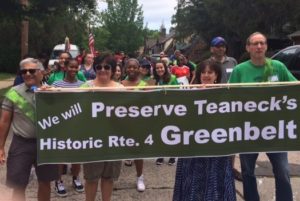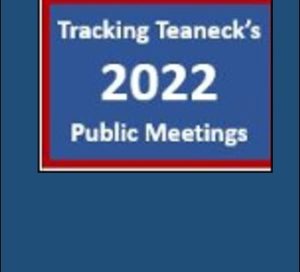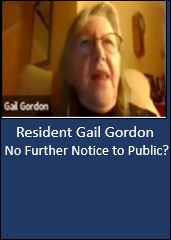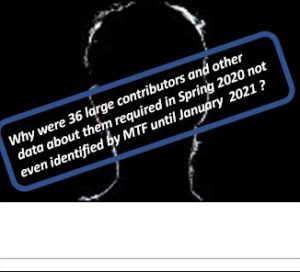Breaking: At 3 pm on 9-5, a new & far worse version of the 7-6 Council Greenbelt resolution was posted on Twp website & marked adopted!?
This new version still includes erroneous (and ruinous) unauthorized revised wording to replace actual Council words that express the consensus for Greenbelt protective highway widening, but now would also explicitly exclude from the Greenbelt and ROSI the Billboard Lot! (a position the State regulations shred!) The new and erroneous version’s Author? Not revealed in the 9/5 Council discussion
However – good news: On 9/5 Greenbelt Committee chair, Marie Warnke, explained how Greenbelt protection & highway renovation can co-exist. Council then directed all parties to get an agreed version – and explicitly directed that it be the version Council actually passed, not a revisionist one. Strong majority support for a full and legitimate Greenbelt emerged in Council discussion of the issue.
Both the Environmental Commission and official Greenbelt Committee are weighing in to secure a correct resolution. The Greenbelt actions on these issues can be read by clicking here
Stay tuned.
Although Council had Killed its Self-Storage Zone Ordinance
at its July 6 Meeting & Embraced an amended Sohn
resolution to again cite the Greenbelt as an Historic District
& to review Town records to include all Route 4 protected Properties,
somehow the Township Website’s version of that Resolution still
MISREPRESENTS the actual Greenbelt Resolution as Council Passed it
(as of Tuesday [9/12] this resolution on the Website is still wrong!)
Video (below in blue) proves SOMEONE is trying to change its meaning
(Such Council records are, under T’s Code, the sole responsibility of the Clerk)
Thus on 7/6 Council backed off after NJDEP Green Acres’ warnings that
the Township had long since agreed that that property would
be used only for open space/conservation purposes –
and thus Council should not proceed to rezone the property
to allow a self-storage facility there.
DEP also verified that the lot proposed for a huge” Billboard”
on Rte 4’s north side was donated property that the Town had agreed (by deed)
– in perpetuity – to use only for public park purposes.
Who had failed to alert the Town about its prior commitments?
That is Complex – Please read below!
…
800 of our folks had signed “protect the Greenbelt”
petitions and they were submitted to Council on 7/6
Council had Introduced many Zoning Change Ordinances it had planned to adopt Thursday July 6
Residents had strongly opposed that big Self-Storage Facility on the east-bound Greenbelt
And residents continued their strong opposition to the 65 ft high flashing west-bound billboard
But not until July 6 did Council allow member Sohn to offer his Greenbelt protection resolution
click here
As noted, unbelievably the Township Website today (9/12) still misstates that Council action. And Councilman Sohn has now posted his efforts to get it corrected as part of the Tuesday 9/5/2017 Council agenda click here
So unfortunately the struggle continues today. Who says the website version is in error? See for yourself. Below is the complete video of the 7/6/2017 Council discussion/votes on Councilman Sohn’s Greenbelt Protection resolution. The Township website version now (illegally and inartfully) limits Greenbelt protection to address highway renovation – whereas the State has already developed EXCELLENT procedures to protect the Greenbelt when a minimally invasive highway expansion proceeds. To see the errant website resolution- click here and then watch the video immediately below:
To see a Power Point summarizing exactly how and why the current website’s version
of this resolution is wrong click here ⇒ correct
Hadn’t the Greenbelt already been protected? If not, why not?
Answer: Because of what three Teaneck Officials in 2010 erroneously had told
State officials is/has been the “real” purpose of the Greenbelt – and did so
to keep all Greenbelt properties off the Recreation and Open Space Inventory (ROSI)
What these officials literally told the State was that the Greenbelt was not created for
open space/conservation but really to expedite a “high speed thoroughfare” on Route 4!
And they told the state this despite the fact that 1) a prior Teaneck Council had declared
the Greenbelt to be an Historic District! (The County and the State subsequently have defined it
as “the Teaneck Route 4 Open Space Historic District (Route 4 Greenbelt)“; AND 2)
they did so despite the fact that in 1966 Council specifically passed
an ordinance (Ordinance #1279) that designated much of the Route 4 buffer as parkland
Scroll down to review the incredible story of this official 2010 misrepresentation to the State
And this failure to properly represent the Township’s prior actions continues in 2017.
What did Township attorney, William Rupp, write about the Route 4 Greenbelt/Greenway in his 4/26/2017 email to Township Planner Preiss – an email read out loud and verbatim by Preiss to the Planning Board just as it was preparing to consider/pass two improper Greenbelt projects: 1) to give final approval to All-Vision’s site plan for the 672 sq.ft. two-sided digital Billboard and 2) give approval to Preiss’ draft 2017 Master Plan Re-examination that included the proposal for self-storage facility. (PS: Ignore the “Subject re Confidential” line! The snip below was obtained through an OPRA request!)
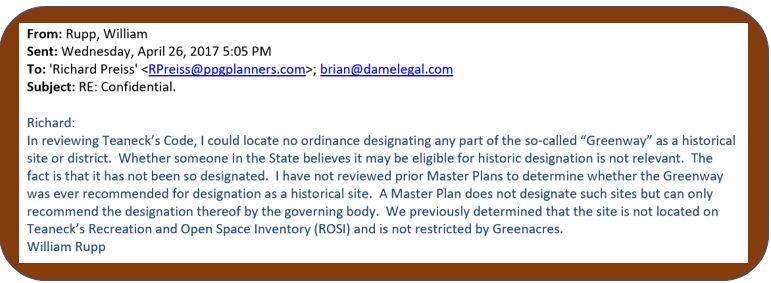
Hmm…. Perhaps that Rupp statement needs substantial amendment! TTT has investigated decisions taken by the state, county & Township and is learning in what way the Greenbelt is, in fact, already a protected historic district and just how inaccurate and misleading is the Rupp reference to there being no Green Acres restrictions.
Just “Someone in the State”, Mr. Rupp? Who has asked that the Greenbelt be an historic district?
Answer: Rigorous State and County studies and the Township Council, its governing board, itself!
- The State: An extensive 39-page survey done in 2014 for the State Office of Historical Preservation (SHPO), led to 9/1/2015 official “Finding” by SHPO that the “Teaneck Route 4 Open Space Corridor Historic District (Teaneck Route 4 Greenbelt)” was “a newly identified resource”, and though not yet on the state and national registries of historic places, it was already to be treated as a full historic district in relation to any federal undertaking affecting it. That is why, directly after that 2015 “Finding”, the Federal Highway Administration (FHWA) and two state agencies( NJ DOT and NJ DEP-SHPO) signed a 9/16/2016 three-way Memorandum of Understanding (MOA) specifying how all 3 would under, FHWA’s Sec. 106, treat that section of the Greenbelt fully as an historic district in designing the Palisade Ave. bridge replacement. But the same restrictions/protections apply to any place on the Greenbelt whenever the Feds are involved. (Oddly, these SHPO findings had not been shared even with Township Commission chairs who were cc’d on the documents sent to the Township until sent to them by TTT!).
- The County: Previously on 4/19/2007, a Bergen County Historic Site Survey designated the Greenbelt as Historic Site #02650-D59 and concluded it “is probable that the Route 4 Greenbelt district is eligible for listing on the State and National Registers of Historic Places”
- The Township: In fact, the Greenbelt as a protected “historic place” had long since been Teaneck Council’s unambiguous conclusion in a 1987 governing body resolution. That Council acknowledged concerns that the Greenbelt might be threatened by NJ DOT’s mid-1980’s Route 4 project plans. In response, the resolution (that was proposed by the late and our beloved Lou Schwartz) clearly states, concern that highway project plans might ignore due protection of the Greenbelt was the primary reason why Council’s Resolution 118-87 (4/7/1987) designated the Greenbelt as an historic site: “the Council would like to maintain this greenbelt in its historic form”. Council in that resolution also “decided to apply for dedication of the greenbelt as an historic landmark” & explicitly authorized “submission of application forms to the NJ and National Registers of Historical Places”.
No one seems to know what happened after those forms were submitted to the state; but as seen above, the state has explicitly now stated the Greenbelt’s eligibility for inclusion in the highest level and most protective state and federal historic site registers.
The narrative found in this 1987 Council resolution directly tracks with virtually every Township’s commitment and rationale for investments made to create the Greenbelt going all the way back to the inception of Township planning documents in 1933.
The same commitment is repeatedly restated and reinforced in diverse Council resolutions, Master Plans and other official and unofficial documents especially whenever there have been threats to the Greenbelt from either destructive highway plan proposals or efforts to allow commercial uses anywhere along Route 4. Those threats to the Greenbelt – and successful efforts to thwart them – were particularly prevalant in the mid-80’s, and then a decade later again specifically in response to a 1997 incident when NJDOT took down hundreds of Greenbelt trees.
BUT, in 2011 came a threat from a very different source: the Township’s own Planning Board. It proposed to Council that Council rezone selected Greenbelt properties to allow commercial (specifically hotel) development on both sides of Route 4 near the Englewood border. That effort collapsed when Council, after strong resident resistance, unanimously rejected the proposed commercial zoning saying explicitly that the Council “has no interest in rezoning any portion of Route 4,” (see Resolution O, August 16, 2011 copied below) Note: All of these public documents define the Greenbelt as extending from the Teaneck-Englewood border to River Road. That definition is important because Planner Preiss’ 2011 Master Plan Re-examination report – adopted intact by the Planning Board – had claimed that the Greenbelt did not begin, on its eastern border, after Decatur. [An OPRA requesting any documentation the Town or Mr. Preiss had to support this idiosyncratic claim yielded no example of any such document])
What are Appropriate Uses and Purposes of Open Space and Historic Districts? The Greenbelt’s current status and new eligibility for additional status and protections as a registered historic district means any that any proposed changes to the Greenbelt properties must be shown to be changes that represent “appropriate uses” for an historic district of any specific type. That is why the Township attorney is now working so hard to deny that the historic district designation is real.
So what are the appropriate uses of the Greenbelt properties? The answer requires understanding for what purpose the Township has been protecting, preserving, and making investment (including the extensive public purchase of Route 4 buffer property) for 86 years – literally since 1931?
An answer to that “what was/is the purpose?” question should help us all understand one other key issue: Why is the the Teaneck Route 4 Open Space Corridor Historic District (Teaneck Route 4 Greenbelt) currently not on the Township’s Recreation and Open Space Inventory (the ROSI). Were it on the ROSI, only Greenbelt property uses consistent with “recreation and conservation” would be allowed by the State. Were the Township then to permit any non-conforming use that would cause Teaneck to lose access to all the State’s Green Acres funding – from which it has greatly benefited in the past and can be expected to benefit in the future!
So who decides what should go on any municipality’s ROSI? Teaneck’s attorneys have since 2009 been mistakenly claiming that only the governing board [Council] can so designate properties. Instead, the right simple answer is, the ROSI is an inventory on which properties are deemed “recreation/conservation” properties that BOTH the municipality and the State agree are all the properties that should be placed there. Why? Because the State and municipal ROSI lists must be reconciled – or be identical – if a municipality is to be eligible for Green Acres funding. (see. N.J.A.C. 7:36-25.3).
It turns out that the last time that State/Teaneck “ROSI reconciliation” occurred was in November of 2010. The Township was then seeking final approval of a $750K funding project ($600K of which was to be a grant) from the State’s Green Acres for Teaneck’s new Sportsplex. That large Green Acres funding project could be approved ONLY if the State and Township had an agreed (a “reconciled”) ROSI.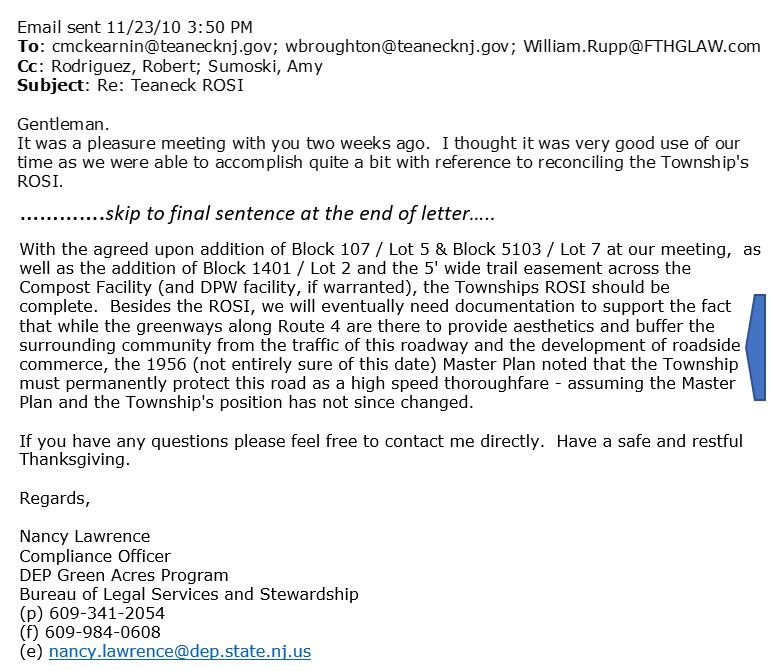
That is why -apparently after months of “behind the scenes negotiation” [Broughton]- the Green Acres state employees who oversee the State’s ROSIs database came to Teaneck in early November 2010 with questions about whether Teaneck’s ROSI was complete. (Click here) One of their issues was whether the Greenbelt should be added to Teaneck’s ROSI. And the right answer would depend on what is the purpose of the Greenbelt and its properties!
We now know what the 3 Teaneck employees told the Green Acres database compliance officer, Nancy Lawrence, because two weeks after her visit and consultation she wrote an email (11/23/2010) confirming the results of the “ROSI reconciliation” discussions. In the final section of the email Compliance Official Lawrence agrees not to insist that the Greenbelt be placed on the ROSI. Though she cites many of the precise characteristics that would require placing Greenbelt properties on the ROSI (aesthetics, buffering from development, etc.), her email then cites what she calls “the fact” – apparently asserted to her by the Township officials – that the real imperative or function served by Greenbelt properties was/is to “protect this road as a high speed thoroughfare”. Hence, presumably, that is why “conservation/ recreation” was not deemed by both Green Acres and the Township to be the Greenbelt’s controlling purpose. (The Image just above is of snips from that Lawrence email. To see the complete email click here)
To whom did the Teaneck officials explain that this was the definition of the Greenbelt that they had just given to the Green Acres Compliance Officer? Who knew that it was only because the Greenbelt’s purpose had become its role in expediting Route 4 as a high speed thoroughfare” that Green Acres had backed off requiring it to be on the ROSI? Apparently no one – at least publicly. The video below of the Manager and Attorney Turitz describing the ROSI negotiation to the Teaneck Council on 11/30/2010 is apparently the only briefing the governing board and the public ever got about the ROSI negotiation matter. You will note in watching the 6-minute video that the two officials provided not the slightest hint that there was any issue related to the Greenbelt. Nothing is said about the rationale the Township had given for excluding those Greenbelt properties from the ROSI. This short video raises serious questions of proper process and the exercise of legitimate municipal authority and of just how little transparency there had been or indeed ever has been in the intervening 7 years since 2010, But also as we shall see, the video also raises intriguing issues about the consistency of the Township’s “positions”.
But we should not get lost prematurely in what the administration told Council. As we have seen from the Lawrence letter of 11/23, it was what Township officials in 2010 told Green Acres about the “high-speed thoroughfare” definition of the Greenbelt’s function/purpose that had actually turned the tide with Green Acres. But we are confident that that depiction of the Greenbelt’s rationale would have/will come as complete surprise to Teaneck officials and residents who have served for decades on the front lines to defend the actual Greenbelt. Many official bodies and parties, surely including NJ’s DOT, will find the idea that the Greenbelt’s primary function is to improve “high speed thoroughfare” as not merely laughable but utterly ironic. The Township has worked for nearly all of the 86 Greenbelt years to get the recognition of the Greenbelt as a natural resource worthy of protection from what the Town has perceived as an often over-zealous pursuit of highway efficiency or commercial development at the expense of the Greenbelt. Thus the very recent SHPO “finding” about the Greenbelt as an historic “open space” district and the new commitments to Greenbelt protection found in the consequent tri-party MOA is being greeted as a victory for the Township’s longstanding Greenbelt advocacy.
But irrespective of whatever it was that the three officials to whom Compliance Officer Lawrence was writing had told her, her letter specifically said she still required documentation – and specifically documentation from the 1956 Master Plan they had referenced in their discussion. The Township Clerk has recently confirmed that no 1956 Master Plan exists! (Remember – ironically, in the video you have just heard Attorney Turitz dismiss the authority of any Master Plan inventory. ) And what documentation did the Township officials then send Compliance Officer Lawrence in response to her email’s request? Nothing. That is the State has no record of that 11/2010 requested “documentation” ever having been provided – at least as of May 2017. [personal communication from Green Acres].
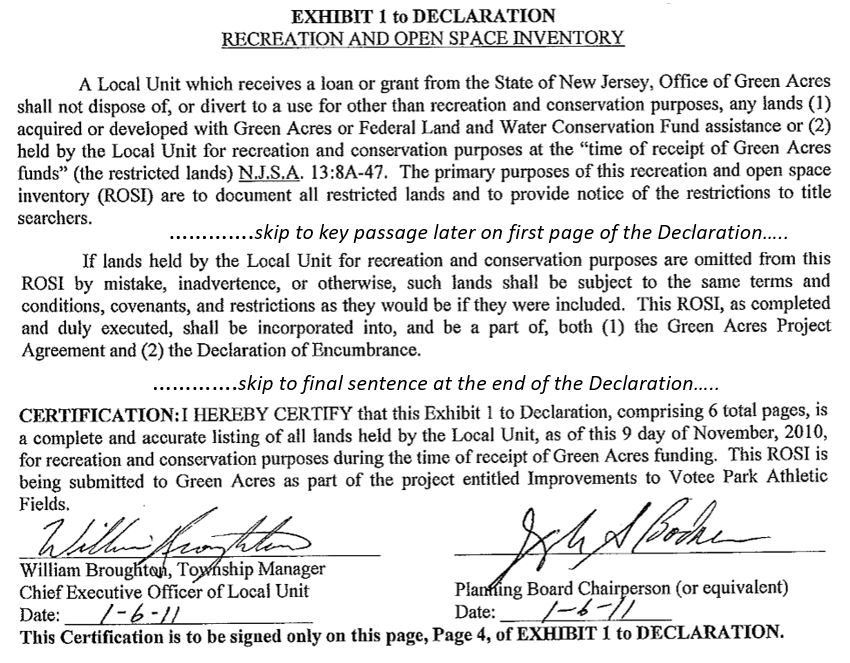 The Township did, however, less than two months after Ms. Lawrence’s letter (1/6/2011) move ahead to provide some different documentation — a signed certification, a Declaration, from the Manager and the Planning Board Chair. Included in the Declaration was the Township’s ROSI list- and as expected it omitted the 192 “Route 4 Greenbelt “properties that had been specifically identified by Block and Lot when cited in the 2007 Open Space and Recreation Plan (Note: that Plan had been incorporated in 2008 into what still today in 2017 Teaneck’s most recent full Master Plan approved by the Planning Board in 2007). Why was that 1/6/2011 “Declaration” problematic? Because it was – whether or not intentionally – completely wrong!
The Township did, however, less than two months after Ms. Lawrence’s letter (1/6/2011) move ahead to provide some different documentation — a signed certification, a Declaration, from the Manager and the Planning Board Chair. Included in the Declaration was the Township’s ROSI list- and as expected it omitted the 192 “Route 4 Greenbelt “properties that had been specifically identified by Block and Lot when cited in the 2007 Open Space and Recreation Plan (Note: that Plan had been incorporated in 2008 into what still today in 2017 Teaneck’s most recent full Master Plan approved by the Planning Board in 2007). Why was that 1/6/2011 “Declaration” problematic? Because it was – whether or not intentionally – completely wrong!
What must a municipality certify about the ROSI the properties it includes? Answer: that its ROSI is “a complete and accurate listing of all lands held …..for recreation and conservation purposes.” Actually, the state’s declaration form is quite clear in several places that ALL eligible recreation and open space properties are to be included – and that failure to do so would result in specific statutorily defined penalties (see Image of declaration clips immediately above and to see the entire declaration click here.)
But what would convince the State in 2017 that the 3 officials who in a professed effort to keep the ROSI inventory limited had not given the State a misleading definition of the function of the Township of the Township’s Greenbelt properties?
A) Clearly “thoroughfare protection” is not what hundreds of Teaneck documents say was/is the Greenbelt’s purpose and its role in the identity and life of this suburban community. Instead, three concepts very much at variance with this “thoroughfare” definition are consistently found as the rationale and purpose that the Town has cited/cites as its reason to have created and protected the Greenbelt throughout a 86 year history: 1) the Greenbelt is for open space and natural resource conservation; 2) it is for residential parkland buffering; and 3) it serves to prevent commercialization along the state highway – a purpose driven by Teaneck’s repeatedly-stated goal of NOT ever becoming “like” what the commercialization of Route 4 in Englewood to the east and Hackensack to the west was becoming/has become. Click here to view some of the many quotes about the Greenbelt definition and rationale from 1) Council resolutions; 2) from Master Plans; 3) from key resource and open space inventories. We believe the sheer quantity and consistency of these diverse statements of Greenbelt purpose invalidate the apparently offhand and undocumented verbal statement of a completely inconsistent purpose made to a state compliance officer in 2010?
B) A review of the two Township documents where the concept of “thoroughfare” protection was in any way cited shows that the concept of the relationship between the Greenbelt as an aid to a high speed thoroughfare was first suggested by a NYC Consultant in 1947 (who likened what he saw in Teaneck to parkways he had helped plan in southern Connecticut). But even this consultant explained that the Greenbelt’s preeminent purpose was to strengthen the prohibitions against pressures for commercialization – and like all of his predecessors this consultant in 1947 railed against cheap commercial developments in the communities to the east and west of Teaneck and saw what he called the Greenbelt’s “park strips” as “maintaining the integrity of the Town Plan” which he viewed centrally as its strong commitment to parks and open space. We know of only one other official town document where the Greenbelt is even indirectly cited for a contribution to traffic management – but does so in context of again citing its prophylactic function against commercialization. (The General Development Plan, 1962):
Through the foresight of Teaneck citizens, all of the abutting right-of-way not owned by the State was purchased by the Township primarily for the purposes of restricting commercial development. Today this right-of-way provides the opportunity for improving access by the provision of improved ramps and allowing for limited deceleration lane construction.
http://www.teaneck.org/virtualvillage/TeaneckDevelopmentPlan/circulation.html
C) Any analysis of how Teaneck officials and entities have argued in behalf of the Greenbelt when confronted with highway project proposals whose purpose and implementation might improve Route 4 as a thoroughfare but involve Greenbelt losses show a consistent pattern. Teaneck officials drawn into dialogue with transportation planners were “there to” and did made arguments precisely to preserve the Greenbelt, not there with the purpose of helping deploy the Greenbelt to aid “thoroughfare” efficiency. A good example is the Teaneck Greenbelt Committee whose charter might seem to suggest a dual purpose:
“Teaneck Greenbelt Committee: “The Committee was formed to protect the open space known as the “Greenbelt” along Route 4 in Teaneck by working with Township officials and NJDOT to improve safety and traffic flow along the highway. It has also been agreed that any land taken from the Greenbelt for highway improvements should be compensated by the State in the purchase of equal open space land within the Township.”
Open space is what the Committee protects; it is that for which the Committee seeks compensation for any loss. Particularly in the 80’s and 90’s this Committee sought ways to save Greenbelt open space while trying to find compromises with an aggressive NJ DOT. But the Committee was outraged and reinvigorated when in 1997 an un-permitted NJ DOT project removed over 500 trees. When the current Committee met on June 29, it issued a strong resolution opposing the proposed Self-storage facility and spoke in defense of the Greenbelt’s open space role in the life of the Teaneck community.
D) There is an argument that those 3 officials who sought to exempt the Greenbelt from the ROSI were operating beyond their authority. In Faulkner Law municipalities governing boards make policy. We have sought and not found any Council action during the 2010 time frame either to authorize this “thoroughfare” enhancement definition of the Greenbelt’s function and purpose or to authorize these officials to state that definition. (Note Attorney Turitz does not in the video discussed above cite ANY authority when stating ex post facto that “the Township has taken the position….”). Indeed that definition is inconsistent with any official Teaneck governing board action of which we are aware. We believe the three Teaneck officials lacked either an documentary basis for their statement of Greenbelt property purpose or the authorization to articulate it in this November 2010 setting.
Compliance officer Lawrence was understandably relying on the veracity of the three officials’ word for the Greenbelt’s purchase but noted “assuming the Master Plan and Township position have not changed since”.
Changed Since When? Ms. Lawrence could have meant two possible time frames.
1) “Changed” since the referenced 1956 Master Plan (the document never sent, remember) We note here that
2) But maybe she meant a much narrow and more recent time frame. That would focus attention on whether the decisions/actions taken by official Township bodies in the 2010 time frame – or indeed during 7 year period beginning in 2010 to the present – would validate the Town’s use of Greenbelt property primarily to contribute to Route 4 as a “high-speed thoroughfare”.
- Within literally seven days of the receipt of the Lawrence email in which the Compliance Officer relies on their being Master Plan documentation to prove the Township’s assertion, Mr. Turitz told Council such Master Plan documentation would in no way validate anything about Township open space land use issues. Attorney Turitz had totally dismissed Master Plans and their ilk as representing legitimate/legal sources for determining what properties are open spaces ones; such documents are advisory until incorporated in governing board decisions. We do not know why the requested documentation was not sent. (Note: I have received notice from the Township Clerk that my 6/2/207 request for records both of Township correspondence to Green Acres in response to its documentation request and for a copy of the 1956 Master Plan cited in the Lawrence 11/23/2010 letter will 4 require extensions of 25 and 30 days to enable the Clerk to locate the requested records. )
- Just 6 months later after the Teaneck/Green Acres ROSI discussions – in early May 2011 – Township Planner Richard Preiss delivered his 32-page 2011 Master Plan Re-examination report which called for commercialization of almost 9 acres of Greenbelt property (most of it town owned) as hotel zones in roadside properties on either side of Route 4 near the Englewood border. Several weeks later (5/25/2011), with the change of one word (“would” to “could”), that report was adopted unanimously by the Township’s Planning Board. Why was that problematic? And yet the specifications for the hotel zones recommended zoning changes that involved curbside commerce inconsistent with, for example, any road widening or thoroughfare enhancement and 2) would unquestionably have turned the primary function of those Greenbelt properties into precisely the commercialization that Teaneck had for 86 years given as one of, if not always, the primary reason for protecting Greenbelt open space . Resident outcry in 2011 soon caused the Township Council entirely to back off this commercialization. in August 2011. (See Resolution O. But it can be demonstrated that completely absent from any of these 2011 discussions was any hint of interest in the Greenbelt serving Route 4 traffic efficiency.
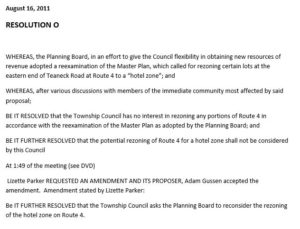
In none of the succeeding 6 years has this fundamental inconsistency between what Teaneck had told Green Acres was its Greenbelt property purposes and the commercial alternatives some Township officials have pursued. Clearly the only rationale offered by Council members was whether the alternative was likely to generate enough municipal revenue [“ratables”] to justify weathering the certain resident public critique when the Township began yielding its open space. Was Council ready to resist – as one attorney and Council member called them – “the tree-huggers” (relevant portion of the official public recording of this session available on request).
Put simply, the Greenbelt land uses proposed (none are yet finally approved) changes since 2010 are now devoted to allowing Greenbelt open space properties to become hosts to: hotel zones, a 672 sq foot double-sided multi-message billboard and a large self-storage facility (whose entrance would surely impede Route 4 traffic). The Self-storage facility described in Ordinance 6046
There is simply a disconnect between the purposes and rules which govern the Green Acres ROSI inclusion requirements and the shift in Greenbelt property commercialization uses currently being pursued by some in the Township leadership. By the clear reading of Green Acre ROSI listing regulations, the status of properties which have have been recreation/conservation lands and have been placed or should have been placed on a municipality’s ROSI are to remain so defined. No township is required to have sought Green Acres funding – and so long as its certifications to the State have been accurate – municipalities can opt out of eligibility for Green Acres funding as long as they keep what have been their commitments. Teaneck Township did not follow those rules in giving accurate certifications. Now, having taken major recreation funding and seeking to stand in line for more, is simultaneously poised to be in ever increasing “non-compliance”. The Township’s jeopardy has been heightened significantly in the past 3 years as the SHPO program has aligned its concern for the Greenbelt’s historical preservation with surveys and findings which in identifying as worthy from an historical point of view the same precise open space (recreation/conservation) characteristics that are central to the Green Acres ROSI definitions and regulations. Again, the name of the historic district defined and now being accepted as an integral element in highway planning is “The Teaneck Route 4 Open Space Corridor Historic District”.
At the very least, it surely is time for those in charge of oversight of the integrity of the Green Acres program to seek clarification from the Township’s officials about all of the issues raised herein and take these matters to whatever is their appropriate resolution — and as is the DEP’s central mandate to assure appropriate use of these valuable NJ recreation/conservation properties.
A quick look back at the Public discussion that had preceded the Council’s reversal and decision not to adopt the Planning Board’s latest (2017) recommendation to rezone part of the Greenbelt:
Self-storage Zoning Proponents make their case
Proponents make theirs ….
A Teaneck Planning Board Member rethinks his 4/27 vote
for the the 2017 Master Plan Re-examination
But — Hadn’t the Greenbelt already been protected? If not, why not?
How did we get here – Background on Actions in early 2017:
Planner’s Master Plan Report Adopted 9-0
Approved major changes in 5 Teaneck Areas
at a Planning Board Meeting – April 27
Eastern section of our Greenbelt – long defined as an historic district – all recommended for zoning to allow commercialization
Planner cites Township Attorney memo which says no “Greenway” [sic] historic district exists
Planner admits he was NOT [after all] “Instructed” to Tell Planning Board that Council requested the Changes
In fact, only 1 of the 5 Changes Described & Illustrated is as described in a Council Resolution
Click at right for a Summary of the Greenbelt issues: The Greenbelt & its appropriate Uses in 2017 – distribute
Click here for the New Proposed Master Plan Report
Click here for proof positive that the Greenbelt is an historic district
Where did the new Plan come from?
A Teaneck Planning Board Meeting on Thursday February 23, 2017
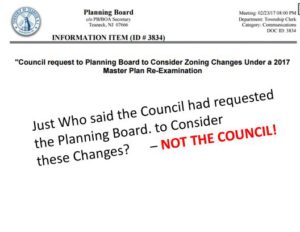 The agenda for the Teaneck Planning Board [PB] meeting for February 23 had a perplexing agenda item, “Council request to Planning Board to consider zoning changes under a 2-17 Master Plan Reexamination”. The agenda packet for all other items addressed that night provided extensive documentation of each agenda issue. But not so for the main event. As is seen in the image to the left, the agenda packet provided a blank page and hence no clue as to what Planner Preiss planned to tell and describe to the Planning Board. As a result, several members of the public had left before the Planner’s presentation. One whom had understandably left is the current chair of the Township’s Environmental Commission, a Commission whose input the PB will be legally required to request for any and all of those changes. (In fact, handed out late in the session – apparently to the Board as well as the public – was a 12-page Preiss presentation document. It is available in its entirety by clicking here. Its content and scope will shock many Township residents. It is apparently still [3/7] not available on the Township website )
The agenda for the Teaneck Planning Board [PB] meeting for February 23 had a perplexing agenda item, “Council request to Planning Board to consider zoning changes under a 2-17 Master Plan Reexamination”. The agenda packet for all other items addressed that night provided extensive documentation of each agenda issue. But not so for the main event. As is seen in the image to the left, the agenda packet provided a blank page and hence no clue as to what Planner Preiss planned to tell and describe to the Planning Board. As a result, several members of the public had left before the Planner’s presentation. One whom had understandably left is the current chair of the Township’s Environmental Commission, a Commission whose input the PB will be legally required to request for any and all of those changes. (In fact, handed out late in the session – apparently to the Board as well as the public – was a 12-page Preiss presentation document. It is available in its entirety by clicking here. Its content and scope will shock many Township residents. It is apparently still [3/7] not available on the Township website )
More significant than this failure to in any way pre-inform the public about the content of his presentation is the language used by the Planner to explain why he was making this presentation to the PB at this time. Repeatedly he told the Planning Board that he was conveying to the Board a “Council Request” – about each of the five areas whose changes he was asking them to ask HIM to write up in a draft Master Plan change.
Here is how the Planner secured the Planning Board approval to proceed:
BUT THERE WAS A VERY SEROUS PROBLEM WITH THE PLANNER’S DESCRIPTION of his mission and his authority to carry it out! Teaneck’s Faulkner Act form of municipal government makes clear that there are only two types of “Council” actions: ordinances and resolutions. Council never actually acts except to enact in one of those two types of legislation – with the limited exception of closed session litigation and private personnel matters decisions. However, there today exists NO Council resolution referencing this package of Council requests and no indication that the Planner was commissioned to carry any request to the Planning Board. There were – buried in the consent agenda of the November 14, 2016 Council meeting – two resolutions which state that Council wants a re-exam of one of the two “areas” and that it wants another look at a second area (the Siegel and Siegel property on the south side of Route 4). Neither of these resolutions 1) reference an author and 2) neither were even mentioned in that 11/14/2016 or any other Council meeting. While there have been discussions of Council interest in the other 3 and 1/2 areas defined by the Planner, these discussions (which occurred on December 7, 2016 and February 7, 2017) have never been discussed as being requests to the PB. Indeed, there has been no public Council discussion AT ALL of some portions of several of the areas Preiss presented. And in respect of several of the other Township areas he discussed, Council had informally asked him to look into them and report back to it – without reference to the Planning Board and without even publicly opining on what either Council or the PB might specifically do about the land uses of those areas.
One zoning change area discussed by Preiss will come as a shock to most Teaneck residents. Although there was a brief informal and indefinite reference to exploring a Hotel area in eastern portions of the Town made by the Mayor in the February 7 Council meeting – the planner was simply asked to explore it and report back to the Council. On the first page and Item 1 of the Planner’s handout presentation to the Planning Board, that suggestion about a change to Hotel Zone of a HUGE Greenbelt area became something the Planner asked the Planning Board to ask him to draft. Yes, it was repeatedly said to be an “informal presentation”. But both the Chair and Planner said its purpose was leading and did lead to a recorded PB roll call vote – a vote to authorize a draft Master Plan re-examination with zoning changes or everything Preiss discussed. (See image above right – although in it the Preiss chart wrongly designates the current zoning of that Block and Lot ). And the giant scope of that zoning change is illustrated by the picture below of the Greenbelt area to be zoned Hotel . The picture depicts the entirety of the Township owned Block 3002 Lot 10 (which extends at least 1/3rd of a mile from the Englewood border to Decatur Ave) – What Preiss now proposes as hotel zone is easily the best and thickest stretch of Teaneck’s revered Greenbelt [the town-owned “asset” long-protected by countless Township actions and listings].
handout presentation to the Planning Board, that suggestion about a change to Hotel Zone of a HUGE Greenbelt area became something the Planner asked the Planning Board to ask him to draft. Yes, it was repeatedly said to be an “informal presentation”. But both the Chair and Planner said its purpose was leading and did lead to a recorded PB roll call vote – a vote to authorize a draft Master Plan re-examination with zoning changes or everything Preiss discussed. (See image above right – although in it the Preiss chart wrongly designates the current zoning of that Block and Lot ). And the giant scope of that zoning change is illustrated by the picture below of the Greenbelt area to be zoned Hotel . The picture depicts the entirety of the Township owned Block 3002 Lot 10 (which extends at least 1/3rd of a mile from the Englewood border to Decatur Ave) – What Preiss now proposes as hotel zone is easily the best and thickest stretch of Teaneck’s revered Greenbelt [the town-owned “asset” long-protected by countless Township actions and listings].
Why now? There is both a previously publicly undisclosed current development proposal for that property and an important history of previously very unsuccessful hotel zoning change proposals for it.
1) Hotel Proposal: an OPRA received on 2/24/2017 contained a copy of development proposal to Council dated in October 2016 that has never been publicly discussed. This, since October the Township has been in possession of a proposal to buy the entire property if only it were all re-zoned for a hotel. (For a copy of that document click here.). So we again see the now familiar pattern of how it works. Proposals are made that state with contingencies: Teaneck change this property from how you have previously zoned it and we will come. And usually, as in this case – the proposal is sent and received without public disclosure. Deja Vu all over again. In 2011, the Planning Board proposed a hotel zone for both sides of Route 4. The proposal was written in a May 9, 2011 report by the same Planner, Richard Preiss (click here). Public opposition to this report’s discussion of use and zoning changes along Route 4 led to a UNANIMOUS decision by Council to reject the entire PB plan as it affected Route 4 – (Resolution O – 8/16/2011). Then Councilwoman Parker strenthened the rejection by proposing an Resolution O amendment (again accepted unanimously) to ask the Planning Board to rescind its Reexamination. (video tape of the /16/2011 meeting available from TTT on request).
The public deserves to know where Mr. Preiss believes this “instruction” was given.
We know there was no public session agenda. Was there, perhaps, a recent Council zoning sub-committee meeting where these zoning suggestions were discussed? Listen very carefully to the tape of Mr. Preiss’ presentation. At 1:51 of the tape Preiss refers to “working with zoning committee and myself:” and then skips back to saying “that the Council would like to move forward”. The equating of a governing board subcommittee with the full Council is not legal under State municipal law. Actions of a municipal governing board [Council in Teaneck’s case] subcommittee have NO INDEPENDENT effect. Indeed all subcommittees in Teaneck are required fully to report their work and recommendations in public Council sessions. Again, a Council subcommittee’s work has NO force or effect unless vetted and passed as resolutions by a Council majority after opportunity for public input.

